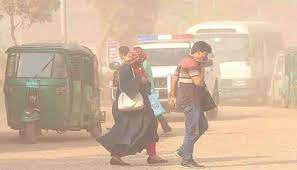
Air pollution and health hazards in Dhaka city in particular and the whole country in general are persistent and perennial. The dwellers of the city, nearly 21 million living in an area of approximately 310 sq. km, had to endure very high health hazards and strangely there were no serious attempts by the government to reduce them. This deplorable situation is known not only to city dwellers but also to Bangladeshis living abroad such that they are seriously deterred from visiting the motherland, particularly in the winter months, when there is no rain and the pollution levels are at highest levels.
Air quality is normally estimated by the concentration of particulate matter (PM) and gaseous substances per unit volume that are present in the air that we breathe. Particulate matter, as the name suggests, is solid matter as well as some water droplets that floats in the air. Obviously large and heavy particulates cannot float in the air. Particulates with 50% having the maximum diameter of 2.5μm (1μm is millionth of a metre) are identified as PM2.5 and are most extensively used as the indicator to measure air pollution. Other indicators such as PM10 as well as gaseous substances such as carbon monoxide (CO), sulphur dioxide (SO2), ozone (O3) and NOx and many more are also used. It has to be stated that PM2.5 is used because it can pass through the human respiratory system relatively easily and settle at various human organs, whereas bigger sizes like PM10 are normally filtered away by human’s filtration system. Once the materials are lodged inside the body, they either stay there intact and build up or get absorbed in the blood stream within the body.
The PM2.5 is taken as main source of cardiovascular and respiratory diseases as they reach terminal bronchioles and alveolar structures; whereas gaseous substances pass through the respiratory system harming the body and eventually get out of the body. The World Health Organisation (WHO) advises that the average annual limit of PM2.5 concentration (μm/m3) should not exceed the target of 35 micrograms per cubic meter. The higher this concentration is, the higher is the health risk. In Bangladesh as a whole, as reported by the World Air Quality Report 2020, the concentration was 77.1μm/m3, which was more than twice the WHO target. It was not only that particular year that Bangladesh exceeded the target, Bangladesh consistently exceeds the target very badly and is almost always nearer the top of the offenders’ list in the world!
The quality of air in day to day speak is specified by Environmental Agencies in terms of Air Quality Index (AQI). All the above-mentioned items such as PM2.5, PM10 and obnoxious gases are taken into account and their relative harm to human health is considered to come to the final quantity called the AQI. Thus, AQI is an indicator of how hazardous the air is for humans. The AQI of below 100 is considered satisfactory and admissible. People can carry out indoor and outdoor activities without any concern from air pollution. An AQI of 101 to 200 is considered to be ‘unhealthy’ for sensitive groups; AQI of 201 to 300 is considered as ‘poor’, whereas AQI of 301 to 400 is considered to be ‘hazardous’ meaning serious health risks to residents.

Road dust, chemical and cement factories, brick kilns, construction works with no dust-dampening measures, are the polluting offenders. Of course, vehicles using petrochemicals are polluting air all the time. The badly maintained vehicles emitting fumes and obnoxious gases are serious offenders in city roads. Breathing polluted air increases a person’s risk of developing heart diseases, lung infection, chronic respiratory diseases and cancer. No wonder that large fraction of human population living in Dhaka suffers from these ailments.
In Dhaka AQI of 184 was recorded yesterday (22 May 2022) making it the most polluted city in the world now, followed by Riyadh in Saudi Arabia (180) and Wuhan in China (173) as the second and third polluting cities. An AQI of 215 was recorded in Dhaka on 21 Dec 2019. Dhaka is the 3rd least liveable city in the world, immediately after Damascus and Lagos.
It is estimated that air pollution takes away on the average 3.05 years of life expectancy in Bangladesh, according to the report by US Health Effects Institute, and Institute for Health Metrics and Evaluation. The life expectancy in Bangladesh is 72.6 years and thus air pollution takes away 4% of human life. This figure in Bangladesh is higher than the neighbouring countries such as India, Bhutan, Pakistan and Afghanistan. Only Nepal exceeds this with 3.05 years of life expectancy loss. The economic burden of air pollution in Dhaka city alone is estimated as US $192 million per annum.
The government must take urgent steps to tackle this menace of air pollution in Dhaka in particular and Bangladesh as a whole in general. It must be stressed that for the sake of health and prosperity of the population of the country and for the world climate, the government must take immediate steps.
- A Rahman is an author and a columnist
